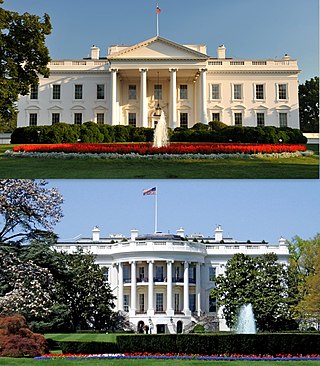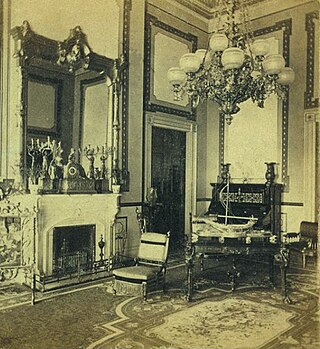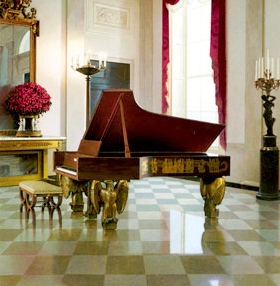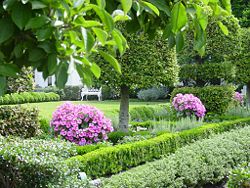
The White House is the official residence and workplace of the president of the United States. It is located at 1600 Pennsylvania Avenue NW in Washington, D.C., and has been the residence of every U.S. president since John Adams in 1800 when the national capital was moved from Philadelphia to Washington, D.C. The term "White House" is often used as metonymy for the president and his advisers.

The White House Rose Garden is a garden bordering the Oval Office and the West Wing of the White House in Washington, D.C., United States. The garden is approximately 125 feet long and 60 feet wide. It balances the Jacqueline Kennedy Garden on the east side of the White House Complex. It is commonly used as a stage for receptions and media events due to its proximity to the White House.

Sonnenberg Gardens and Mansion State Historic Park is a 50-acre (20 ha) state park located at 151 Charlotte Street in Canandaigua, New York, at the north end of Canandaigua Lake, in the Finger Lakes region of Upstate New York. The house and gardens are open to the public every day, May through October.

The Blue Room is one of three state parlors on the first floor in the White House, the residence of the president of the United States. It is distinctive for its oval shape. The room is used for receptions and receiving lines and is occasionally set for small dinners. President Grover Cleveland married Frances Folsom in the room on June 2, 1886, the only wedding of a President and First Lady in the White House. The room is traditionally decorated in shades of blue. With the Yellow Oval Room above it and the Diplomatic Reception Room below it, the Blue Room is one of three oval rooms in James Hoban's original design for the White House.

The Red Room is one of three state parlors on the State Floor in the White House, the Washington D.C. home of the president of the United States. The room has served as a parlor and music room, and recent presidents have held small dinner parties in it. It has been traditionally decorated in shades of red. The room is approximately 28 by 22.5 feet. It has six doors, which open into the Cross Hall, Blue Room, South Portico, and State Dining Room.

The Vermeil Room is located on the ground floor of the White House, the official residence of the president of the United States. The room houses a collection of silver-gilt or vermeil tableware, a 1956 bequest to the White House by Margaret Thompson Biddle. Portraits of American First Ladies hang in the room.

The Diplomatic Reception Room is one of three oval rooms in the Executive Residence of the White House, the official home of the president of the United States. It is located on the ground floor and is used as an entrance from the South Lawn and a reception room for foreign ambassadors to present their credentials, a ceremony formerly conducted in the Blue Room. The room is the point of entry to the White House for a visiting head of state following the State Arrival Ceremony on the South Lawn. The room has four doors, which lead to the Map Room, the Center Hall, the China Room, and a vestibule that leads to the South Lawn.

The Cross Hall is a broad hallway on the first floor in the White House, the official residence of the president of the United States. It runs east to west connecting the State Dining Room with the East Room. The room is used for receiving lines following a State Arrival Ceremony on the South Lawn, or a procession of the President and a visiting head of state and their spouses.

The Yellow Oval Room is an oval room located on the south side of the second floor in the White House, the official residence of the president of the United States. First used as a drawing room in the John Adams administration, it has been used as a library, office, and family parlor. It was designated the Yellow Oval Room during the restoration overseen by First Lady Jacqueline Kennedy. Today the Yellow Oval Room is used for small receptions and for greeting heads of state immediately before a State Dinner.

The President's Dining Room is a dining room located in the northwest corner of the second floor of the White House. It is located directly above the Family Dining Room on the State Floor and looks out upon the North Lawn. The Dining Room is adjacent to the Family Kitchen, a small kitchen designed for use by the First Family, and served by a dumbwaiter connected to the main kitchen on the ground floor.

The Treaty Room is located on the second floor of the White House, the official residence of the president of the United States. The room is a part of the first family's private apartments and is used as a study by the president.

The Cabinet Room is the meeting room for the officials and advisors to the president of the United States who constitute the Cabinet of the United States. The room is located in the West Wing of the White House, adjoining the Oval Office, and looks out upon the White House Rose Garden.

The Roosevelt Room is a meeting room in the West Wing of the White House, the home and main workplace of the president of the United States. Located in the center of the wing, near the Oval Office, it is named after two related U.S. presidents, Theodore Roosevelt and Franklin D. Roosevelt, who contributed to the wing's design.
Rachel Lambert "Bunny" Mellon was an American horticulturalist, gardener, philanthropist, and art collector. She designed and planted a number of significant gardens, including the White House Rose Garden, and assembled one of the largest collections of rare horticultural books. Mellon was the second wife of philanthropist and horse breeder Paul Mellon.

The White House chief floral designer is responsible for the planning, design, arrangement, and placement of all floral decorations for the first family, their private entertaining, and official state functions at the White House, the official residence and principal workplace of the president of the United States. The current chief floral designer is Hedieh Ghaffarian.

The Entrance Hall is the primary and formal entrance to the White House, the official residence of the president of the United States. The room is rectilinear in shape and measures approximately 31 by 44 feet. Located on the State Floor, the room is entered from outdoors through the North Portico, which faces the North Lawn and Pennsylvania Avenue. The south side of the room opens to the Cross Hall through a screen of paired Roman Doric columns. The east wall opens to the Grand Staircase.

The Grand Staircase is the chief stairway connecting the State Floor and the Second Floor of the White House, the official home of the president of the United States. The stairway is primarily used for a ceremony called the Presidential Entrance March. The present Grand Staircase, the fourth staircase occupying the same general space, was completed in 1952 as a part of the Truman White House reconstruction. The Grand Staircase is entered on the State Floor from the Entrance Hall.

The North Lawn at the White House in Washington, D.C., is bordered on the north by Pennsylvania Avenue with a wide view of the mansion, and is screened by dense plantings on the east from East Executive Drive and the Treasury Building, and on the west from West Executive Drive and the Old Executive Office Building. Because it is bordered by Pennsylvania Avenue, the White House's official street address, the North Lawn is sometimes described as the front lawn.

The South Lawn at the White House in Washington, D.C., is directly south of the house and is bordered on the east by East Executive Drive and the Treasury Building, on the west by West Executive Drive and the Old Executive Office Building, and along its curved southern perimeter by South Executive Drive and a large circular public lawn called The Ellipse.
Irvin Williams was an American gardener who was the longest serving White House head gardener, serving from 1962 to 2008. He was a key figure in the design of the White House Rose Garden.

























